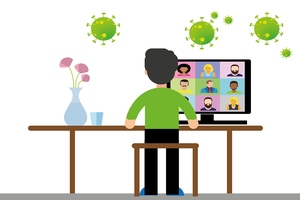4 Ways COVID-19 Has Changed Product Specifications
- < 3 Product Manufacturer Specification Strategies Ranked
- > 3 Ways To Get Your Building Products Specified For WELL Projects
The COVID-19 pandemic devastated the global economy in 2020. The pandemic inflicted severe damage to the construction industry and caused manufacturing job losses, delayed several high dollar projects, and struck fear into many manufacturers. The good news is that vaccines have been rolled out across the country and helped return the AEC industry back to some form of normalcy.
Although COVID-19 is still a major concern in the U.S. and especially in developing countries, the tide seems to be turning. We will never truly live in a 100% “post-pandemic” world since new variants of COVID will arise and other diseases will impact the U.S. workforce and economy. According to Moody’s Analytics, as of July 2021, the U.S. economy is operating at 91%. Job lay-offs have fallen back to pre-recession levels. Some supply chains have improved although some are very problematic. Capitol is flowing, forecasters have raised global growth projections, and there is a stronger risk appetite amongst investors.
However, these new high growth rates do not necessarily signal a sustained upturn in economic activity so manufacturers should be cautious. How can building product manufacturers navigate this “post-pandemic” world and succeed at getting their products specified?
Many standard ways of doing things in the AEC industry have changed due to COVID-19. Whether or not they become permanent fixtures of the industry remain to be seen. Here four major trends and changes that have carried over from the height of the pandemic and affect product specification today and possibly into the future:
- Design professionals working remote
- Remote Product Specification Presentations For AEC Firms
- Heavy reliance on online courses and webinars to reach decision makers
- Increased requests for LEED documentation and HPDs
One of the biggest workplace changes during the pandemic for the AEC industry, was the migration of design professionals to working remotely from home. For a large part 2020 and well into 2021, most product reps were not able to visit AEC firms in person. Large to small architecture firms banned in-office visits, face to face AIA lunch and learns, and product demonstrations. This had a major negative effect for building product manufacturers and upended decades of traditional outreach strategies. COVID killed the traditional work place and the results may last for years.
Since building product manufacturers couldn’t visit AEC firms in person during the height of the COVID-19 crisis, they had to turn to other methods to reach specifiers and decision makers. Progressive and leading-edge product manufacturers who already had strong online platforms and digital outreach programs easily transitioned to remote product presentations. Companies with existing Zoom, GoToWebinar, and other remote networking programs were able to ride the storm and reach the decision makers.
Product manufacturers with zero or few online courses and webinar programs suffered greatly during the crisis. Manufacturers with outdated websites, social media programs, and poor digital resources experienced significant issues and negative outcomes. Companies that invested heavily and smartly over the past few years in their websites and outreach programs like webinars made the transition easier and more effectively. Close collaboration and harnessing the power of technology helped many companies succeed during the pandemic.
Finally, AEC firms became much more stringent with their specification requirements during the COVID crisis. LEED documentation, HPDs, Declare Labels, and various product tests became more entrenched and requested by specifiers. Manufacturers who didn’t have LEED v4 documentation and HPDs lost jobs and specification opportunities.
Only a fool would try and predict the future. The COVID pandemic has changed our industry and the way we get products specified. However, there are methods we recommend that building product manufacturers implement to combat the current effects of the pandemic and any future calamities down the road. The strategies include:
- Develop remote product presentations for AEC firms
- Deliver online courses and webinars
- Create LEED documentation and HPDs
- Educate your product reps about LEED
- Promote your products on platforms such as mindful MATERIALS and the Transparency Catalog
If the construction industry is hit with another significant pandemic or economic recession down the road, you are going to want to have these programs in place to succeed in the marketplace. Manufacturers who don’t use these strategies will lose market share. Successful companies will use all of them.
For more information or to discuss the topic of this blog, please contact Brad Blank





